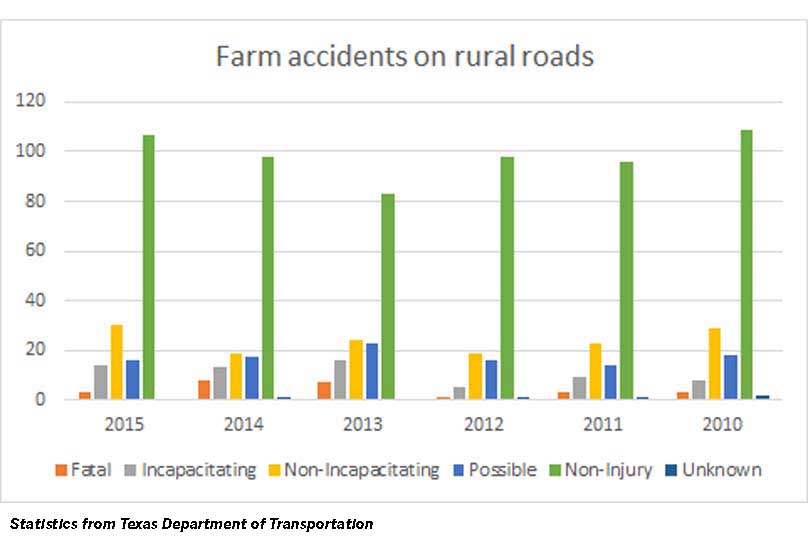By Julie Tomascik
Associate Editor
At the farm. In the tractor. Or on the road. Injuries or fatalities can be one accident away. Operating farm equipment can be a high risk scenario.
With agriculture ranked as one of the most dangerous occupations in the U.S., safety on farms and ranches is of the utmost concern. And even more important on Texas roadways.
Data from the Texas Department of Transportation (TxDOT) shows accidents involving farm equipment on rural and urban roads has shown slight increases since 2011—up from 197 accidents in 2011 to 233 in 2015.
In 2011, 146 accidents happened on rural roads, while 51 took place on urban roads. In 2015, there were 170 accidents on rural roadways and 63 on urban roads.
“The numbers from TxDOT include only farm equipment—combines, tractors, shredders, etc.,” said Mike Pacheco, Texas Farm Bureau associate Legislative director. “Accidents are more routinely found on rural roads, because farm equipment is more common in those areas.”
The numbers for the nation are staggering. The U.S. Department of Transportation estimates 15,000 collisions involving farm vehicles occur on U.S. roadways each year.
Although the road less traveled offers a scenic route, it also offers a chance for danger. Because the hills and scenic views on rural routes can be distracting.
Coming around a sharp turn or topping a steep hill can bring drivers up on slow-moving vehicles like farm equipment.
Sometimes it’s too late to stop.
“Even if you have the right-of-way, it’s important to keep an eye out for others,” Pacheco said.
According to the U.S. Department of Transportation, only 19 percent of Americans live in rural areas, but about 55 percent of highway deaths occur on roads that are considered rural.
The Texas Department of Insurance Division of Workers’ Compensation Workplace Safety offers tips for farm tractor road safety.
Each year since 1944, the third week of September has been recognized as National Farm Safety and Health Week. This year, the week is celebrated from Sept. 18-24. It serves as an opportunity to emphasize the importance of working together to prevent injuries or illnesses on farms and ranches.
Additional information and resources for the week are available through the National Education Center for Agricultural Safety. Short safety videos are available on the U.S. Agricultural Safety and Health Centers’ YouTube channel.


An interesting article personally I would like to know what is the primary reason for the increase in accidents,and if cell phone use has been a part of the increased on road accidents.
Thanks for reading, Greg. According to the data, the general increase is due to the increase of people on the roads. The increase isn’t enough to completely blame it on phones. Additionally “distracted” driving actually decreased 1 percent from 2014 to 2015. The per capita rate of deaths on the road goes up and down and can be correlated to gas prices, the economy overall and when population booms occur.
I was brought up on a farm and we had to move tractors and implements between different locations. I remember my Daddy telling me to stay besides the pavement unless I had to move onto the road. But I have seen neighbors in recent years driving tractors on the road and never moving off the pavement to let vehicular traffic by. From my upbringing that is just disrespectful to others on the roads. I also see ATV’s being driven on public roads regular rly and never moving off the pavement and this bothers me too. I am pretty sure a lot of these complain about the bicyclists on the road and not moving over but they don’t realize if they don’t move over where they can with a tractor or other farm vehicles they are no better.
Thanks for reading, Mike! When I move farm equipment, I stay on the road. But when traffic is coming toward me, I try to move over a safe distance—safe for me and the other drivers. If I have to, I find a safe spot and wait for the oncoming traffic to pass me. Some of your neighbors may not have a safe space to move over into, or they may not feel comfortable moving that far over.